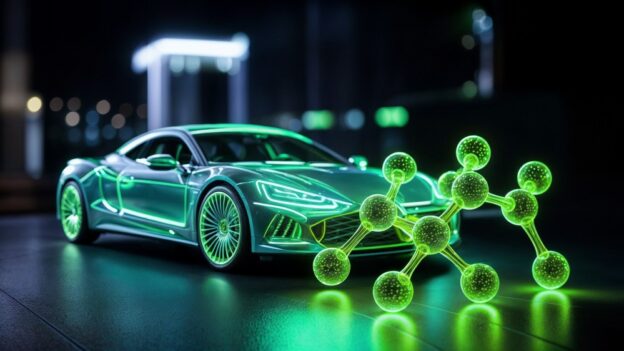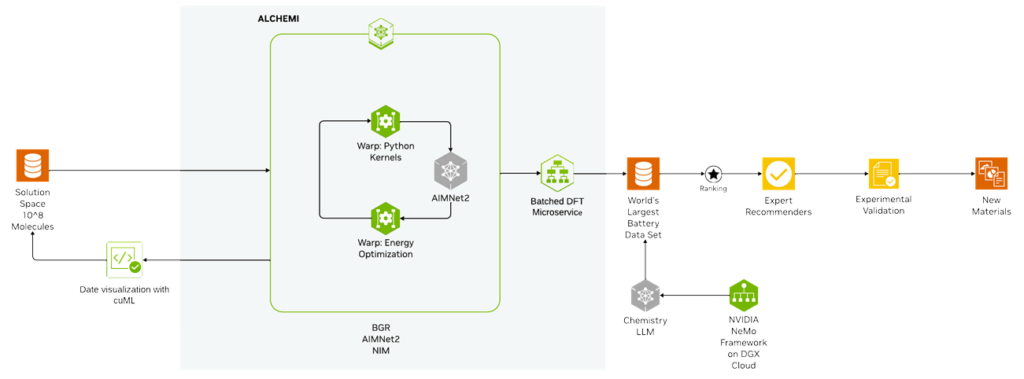Electric vehicles (EVs) are transforming transportation, but challenges such as cost, longevity, and range remain barriers to widespread adoption. At the heart of these challenges lies battery technology—specifically, the electrolyte, a critical component that enables energy storage and delivery. The electrolyte’s properties directly impact a battery’s charging speed, power output, stability, and safety.
To overcome these hurdles, researchers are turning to AI-driven approaches to accelerate the discovery of novel battery materials.
SES AI, a leader in battery innovation, is leveraging the cutting-edge NVIDIA hardware and software ecosystem to revolutionize materials discovery. By combining domain-adapted LLMs with an AI model and GPU-accelerated simulations in a single workflow, SES AI compresses decades of research into months and unlocks groundbreaking advancements in EV battery performance.
SES AI’s approach to battery innovation
SES AI’s pioneering work is structured into the following key steps:
- Mapping the molecular universe
- Advancing chemistry LLMs
- Constructing high-performance batteries
Mapping the molecular universe
SES AI is creating a comprehensive molecular dictionary to map the physical and chemical properties of millions of small molecules. This effort lays the foundation for advanced material discovery. At the heart of their workflow is AIMNet2 (Atoms in Molecules Neural Network)—a neural network potential developed by Carnegie Mellon University’s Isayev Lab that dramatically improves the speed and accuracy of molecular simulations and property predictions.
Qichao Hu, CEO of SES AI, explains, “The goal of our molecular universe effort is to map the properties of small molecules so that we can develop better energy storage devices—for flying cars, humanoid robots, data centers, and more. With this collaboration with NVIDIA using AIMNet2, we’ve accelerated this process from several thousand years to just a few months.”
Advancing chemistry LLMs
By leveraging general intelligence across scientific domains, SES AI enhances reasoning capabilities to accelerate battery material discovery. Their domain-specific Chemistry LLM provides researchers with an intuitive tool for next-generation battery development.
Constructing high-performance batteries
SES AI rapidly evaluates candidate materials in prototypes to showcase significant performance enhancements—paving the way for safer, longer-lasting EV batteries.
Using the NVIDIA platform for breakthroughs
SES AI relies on NVIDIA’s comprehensive platform to navigate the vast solution space of over 100M molecules. Figure 1 shows SES AI’s workflow where the key innovations include accelerated molecular simulations, optimized interactive data exploration, and improved LLM accuracy.
NVIDIA enables 1.6Kx acceleration with simulation workflows: 20x hardware acceleration from Skylake CPUs to 500 NVIDIA H100 GPUs and 80x acceleration with NVIDIA ALCHEMI software.
The Chemistry LLM demonstrates 25% increase in accuracy: LLM as a judge evaluator selected the percentage of correct answers for SES AI 70B Reasoning LLM v Llama-3.1 70B on internal benchmark tasks. 25% is the average increase in accuracy.
Accelerated molecular simulations
Using NVIDIA ALCHEMI, SES AI employs the Batched Geometric Relaxation (BGR) with AIMNet2 NIM microservice and the Batched Density Functional Theory (DFT) microservice to simulate molecular structures rapidly. These tools enable researchers to calculate critical properties such as the HOMO-LUMO gap, which determines a molecule’s electronic characteristics and energy storage potential.
The BGR AIMNet2 NIM microservice is used to accelerate the process of finding the most stable molecular configuration of each molecule. The Batched DFT microservice augments GPU4PySCF, an open-source, GPU-accelerated Python package integrated into Python-based Simulations of Chemistry Framework (PySCF).
With these innovations, SES AI achieves unparalleled efficiency in quantum chemistry calculations.
Interactive data exploration
SES AI uses NVIDIA cuML to accelerate UMAP for dimensionality reduction and HDBSCAN for clustering to create interactive maps of millions of molecules. These tools empower scientists to uncover patterns in complex datasets and identify promising candidates faster than ever before.
Training Chemistry LLMs
To train their Chemistry LLM on 35B tokens from 17M scientific papers, SES AI used NVIDIA DGX Cloud with NVIDIA NeMo, which is a framework for building domain-specific generative models.
To achieve higher model accuracy, the SES team used NeMo Curator features such as exact deduplication, numbers filter, word count filter, repeated lines filter, and non-alphanumeric filter.
The outcome is a customized model that is more accurate than its base version in ranking molecules and providing actionable insights, accelerating discovery at an unprecedented rate.
Results: Transforming battery technology
The collaboration between SES AI and NVIDIA has yielded remarkable results:
- 17 candidate materials identified: Two have already undergone synthesis and testing at SES AI’s Electrolyte Foundry in Woburn, Massachusetts.
- 20% improvement in battery cycle life: Early tests show significant performance enhancements
- 1.6Kx acceleration and 2x the energy efficiency in BGR and DFT workflows: Achieved through NVIDIA H100 GPUs, NVIDIA ALCHEMI’s BGR AIMNet2 NIM, and Batched DFT Microservice.
- 10x faster data exploration: Enabled by NVIDIA cuML.
- 25% increase in LLM accuracy: Chemistry LLM, using NVIDIA DGX Cloud and NVIDIA NeMo, surpasses the base model in molecular ranking and reasoning tasks.
These advancements have led to innovations:
- Lithium metal batteries: Provides enhanced performance and safety.
- High-silicon lithium-ion batteries: A newly identified solvent molecule addresses expansion issues without emitting harmful gases at high temperatures.
As a result, SES AI has signed agreements to develop electrolyte materials for EVs with two automotive OEM partners.
Driving sustainability with accelerated innovation
Historically, discovering a truly innovative battery electrolyte took five years. Today, thanks to SES AI and NVIDIA technologies, significant breakthroughs are emerging every six months. These advancements promise EV batteries with enhanced performance, safety, and lifecycle—reducing greenhouse gas emissions while driving sustainable practices globally.
The rapid discovery of new materials accelerates technological progress, stimulates economic growth, and supports global efforts to combat climate change.
Empowering researchers worldwide
NVIDIA tools are empowering researchers worldwide to accelerate materials discovery:
- Sign up to receive notification when the NVIDIA Batched Geometry Relaxation NIM microservice is available for download.
- Build custom generative models with NVIDIA NeMo.
- Use cuML Python libraries for faster ML workflows without code changes.
Together with partners such as SES AI, NVIDIA is driving innovation that will shape the future of energy storage—and inspire a more sustainable world.
For more information, see the recent GTC sessions:
- AI-Accelerated Materials Discovery for Next-Generation Lithium Metal Batteries
- Build Lighting-Fast Data Science Pipelines in Industry with Accelerated Computing
Acknowledgments
Thanks to Yumin Zhang, Dan Hannah, Vignesh Prabhakar, Md Amirul Islam, Adam Atanas, Richard Chang, Kai Liu, Kang Xu, and Qichao Hu for their contributions.
Related resources
- GTC session: The New Role of AI in Electric Vehicles
- GTC session: Accelerate the Future of AI-Defined Vehicles and Autonomous Driving
- GTC session: Discover Breakthroughs in AI, In-Vehicle Supercomputing, and Quantum to Achieve Operational Excellence (Presented by DXC Technology Services, LLC)
- NGC Containers: TTS FastPitch HifiGAN Riva
- Webinar: Using GPUs to Accelerate HD Mapping and Location-Based Services
- Webinar: Demystifying Edge AI from Proof of Concept to Production
- https://developer.nvidia.com/blog/accelerating-the-future-of-transportation-with-ses-ais-nvidia-powered-innovation-for-electric-vehicles/






